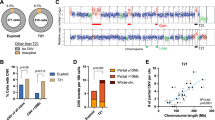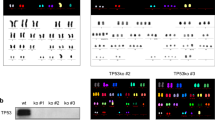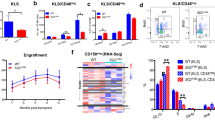Abstract
Mice null for the Pms2 mismatch repair (MMR) gene exhibit a predisposition to lymphoma, microsatellite repeat instability, and failure of spermatogenesis. To study the role of Pms2 in the maintenance of in vivo genomic integrity in somatic cells, we characterized Aprt mutations in T cells and fibroblasts of 129×C3H Pms2−/−Aprt+/− mice. The spontaneous frequency of DAP-resistant T lymphocytes, as a consequence of APRT-deficiency, was increased threefold. Point mutation, which accounted for less than 20% of the DAPr mutant clones in Pms2+/+ mice, was predominant in the mutant T cell clones from Pms2−/− mice. These point mutations were predominantly TA to CG transitions. Fibroblasts of Pms2−/− mice exhibited only a modest increase in the frequency of clones with point mutations, such that mitotic recombination was still the primary cause of APRT deficiency. Thus, the mutator phenotype as a consequence of PMS2 deficiency is tissue-dependent, which may be related to the tissue-specific tumor proneness of Pms2−/− mice.
This is a preview of subscription content, access via your institution
Access options
Subscribe to this journal
Receive 50 print issues and online access
$259.00 per year
only $5.18 per issue
Buy this article
- Purchase on Springer Link
- Instant access to full article PDF
Prices may be subject to local taxes which are calculated during checkout



Similar content being viewed by others
References
Andrew SE, Reitmair AH, Fox J, Hsiao L, Francis A, McKinnon M, Mak TW, Jirik FR . 1997 Oncogene 15: 123–129
Andrew SE, Xu XS, Baross-Francis A, Narayanan L, Milhausen K, Liskay RM, Jirik FR, Glazer PM . 2000 Carcinogenesis 21: 1291–1295
Baker SM, Bronner CE, Zhang L, Plug A W, Robatzek M, Warren G, Elliott EA, Yu J, Ashley T, Arnheim N, Flavell RA, Liskay RM . 1995 Cell 82: 309–319
Baross-Francis A, Makhani N, Liskay RM, Jirik FR . 2001 Oncogene 20: 619–625
Bielas JH, Heddle JA . 2000 Proc. Natl. Acad. Sci. USA 97: 11391–11396
Buermeyer AB, Deschenes SM, Baker SM, Liskay RM . 1999 Annu. Rev. Genet. 33: 533–564
Dush MK, Sikela JM, Khan SA, Tischfield JA, Stambrook PJ . 1985 Proc. Natl. Acad. Sci. USA 82: 2731–2735
Engle SJ, Stockelman MG, Chen J, Boivin G, Yum MN, Davies PM, Ying MY, Sahota A, Simmonds HA, Stambrook PJ, Tischfield JA . 1996 Proc. Natl. Acad. Sci. USA 93: 5307–5312
Gong JG, Costanzo A, Yang HQ, Melino G, Kaelin Jr WG, Levrero M, Wang JY . 1999 Nature 399: 806–809
Harfe BD, Jinks-Robertson S . 2000 Annu. Rev. Genet. 34: 359–399
Kolodner RD, Marsischky GT . 1999 Curr. Opin. Genet. Dev. 9: 89–96
Melton DW, Konecki DS, Brennand J, Caskey CT . 1984 Proc. Natl. Acad. Sci. USA 81: 2147–2151
Meng Q, Skopek TR, Walker DM, Hurley-Leslie S, Chen T, Zimmer DM, Walker VE . 1998 Environ. Mol. Mutagen. 32: 236–243
Mirsalis JC, Monforte JA, Wineger RA . 1995 Annu. Rev. Pharmacol. Toxicol. 35: 145–164
Modrich P, Lahue R . 1996 Annu. Rev. Biochem. 65: 101–133
Narayanan L, Fritzell JA, Baker SM, Liskay RM, Glazer PM . 1997 Proc. Natl. Acad. Sci. USA 94: 3122–3127
Prolla TA, Baker SM, Harris AC, Tsao JL, Yao X, Bronner CE, Zheng B, Gordon M, Reneker J, Arnheim N, Shibata D, Bradley A, Liskay RM . 1998 Nat. Genet. 18: 276–279
Rose JA, Yates PA, Simpson J, Tischfield JA, Stambrook PJ, Turker MS . 2000 Cancer Res. 60: 3404–3408
Shaddock JG, Dobrovolsky VN, Mittelstaedt RA, Bendre S, Heflich RH, Parsons BL . 2001 Environ. Mol. Mutagen. 37: 68–
Shao C, Deng L, Henegariu O, Liang L, Raikwar N, Sahota A, Stambrook PJ, Tischfield JA . 1999 Proc. Natl. Acad. Sci. USA 96: 9230–9235
Shao C, Deng L, Henegariu O, Liang L, Stambrook PJ, Tischfield JA . 2000 Proc. Natl. Acad. Sci. USA 97: 7405–7410
Shao C, Stambrook PJ, Tischfield JA . 2001 Nat. Genet. 28: 169–172
Toft NJ, Winton DJ, Kelly J, Howard LA, Dekker M, te Riele H, Arends MJ, Wyllie AH, Margison GP, Clarke AR . 1999 Proc. Natl. Acad. Sci. USA 96: 3911–3915
Yao X, Buermeyer AB, Narayanan L, Tran D, Baker SM, Prolla TA, Glazer PM, Liskay RM, Arnheim N . 1999 Proc. Natl. Acad. Sci. USA 96: 6850–6855
Zeng M, Narayanan L, Xu XS, Prolla TA, Liskay RM, Glazer PM . 2000 Cancer Res. 60: 4889–4893
Zhang H, Richards B, Wilson T, Lloyd M, Cranston A, Thorburn A, Fishel R, Meuth M . 1999 Cancer Res. 59: 3021–3027
Acknowledgements
We thank RM Liskay for generously providing us with Pms2 knockout mice. This work was supported by grants from NIH (R01DK38185, P01ES05652 and P30ES05022).
Author information
Authors and Affiliations
Corresponding author
Rights and permissions
About this article
Cite this article
Shao, C., Yin, M., Deng, L. et al. Loss of heterozygosity and point mutation at Aprt locus in T cells and fibroblasts of Pms2−/− mice. Oncogene 21, 2840–2845 (2002). https://doi.org/10.1038/sj.onc.1205358
Received:
Revised:
Accepted:
Published:
Issue Date:
DOI: https://doi.org/10.1038/sj.onc.1205358



